Beethoven: 1808 Reconstructed, Aimard, Philharmonia, Salonen, RFH review - a feast in fading light | reviews, news & interviews
Beethoven: 1808 Reconstructed, Aimard, Philharmonia, Salonen, RFH review - a feast in fading light
Beethoven: 1808 Reconstructed, Aimard, Philharmonia, Salonen, RFH review - a feast in fading light
In dark times, an epic reconstruction of a historic concert

Like it or not, we live – as Beethoven did – in interesting times. In place of the revolutions, wars and occupations that convulsed the cities he knew, we now confront a silent, invisible foe that breeds an equal terror.
Directed by Gerard McBurney, narrated by Stephen Fry, and anchored by the Philharmonia under Esa-Pekka Salonen, Beethoven: 1808 Reconstructed would have felt like a special occasion under any circumstances. On a day when, as Fry noted, we enjoyed what might turn out to be our last public event for quite some time, and as the RFH stage intermittently darkened to produce an eerie candlelit effect, this celebration of “humanity’s greatest champion” (Fry again) had an end-of-days feel that tempered its exuberance.
Well, if we must abandon live music for a while, 1808 Reconstructed sent us out with a bang (expertly delivered on various occasions by the Philharmonia’s ace timpanist Antoine Siguré). This super-sized concert aimed to reproduce the Christmas “Academy” of 22 December 1808 at the Theatre an der Wien. There Beethoven – as promoter, director and star pianist in one – showcased (mostly) new work: the Fifth and Sixth Symphonies; the Fourth Piano Concerto; the Choral Fantasy, and chunks of the Mass in C, along with a couple of shorter pieces. We heard virtually the whole programme, in the original order, interspersed with readings by a wandering Fry – at his most droll and genial – from the critics and diarists who welcomed this avalanche of genius with rapture, perplexity, or sheer boredom. Johann Friedrich Reichardt, on hearing the Fifth not long after the Pastoral, tetchily exclaimed: “Another symphony… absurdly elaborate, and much too long”. There was plenty of amusement to be had at the tin-eared and mean-minded reaction of some of the Titan’s Viennese contemporaries. Fry milked these passages like the pro he is, but we could also marvel at those greater spirits – like ETA Hoffmann – who heard the Fifth and knew at once that the world had changed. The prophet was never entirely without honour on home ground.  These extracts, and the atmospheric lighting (designed by Rick Fisher), pushed McBurney’s creation in the direction of a sort of period pageant – though, thankfully, no one forced silly costumes on the musicians. We came, however, not primarily for the words but the music. Here the Philharmonia, accompanied by pianist Pierre-Laurent Aimard (pictured above, a late replacement for Andreas Haefliger), the Philharmonia Voices, the Rodolfus youth choir and a handful of vocal soloists, delivered with an impressive stamina and focus that never ruled out the light and shade that this massive suite of masterpieces demanded. Unfamiliar with the epic span of musical events two centuries ago, the audience too might have flagged over the four-hour trek. Salonen by and large ensured that we did not. He achieved that with a generally light-footed, swift-flowing and open-textured approach to the time-encrusted miracles of these scores.
These extracts, and the atmospheric lighting (designed by Rick Fisher), pushed McBurney’s creation in the direction of a sort of period pageant – though, thankfully, no one forced silly costumes on the musicians. We came, however, not primarily for the words but the music. Here the Philharmonia, accompanied by pianist Pierre-Laurent Aimard (pictured above, a late replacement for Andreas Haefliger), the Philharmonia Voices, the Rodolfus youth choir and a handful of vocal soloists, delivered with an impressive stamina and focus that never ruled out the light and shade that this massive suite of masterpieces demanded. Unfamiliar with the epic span of musical events two centuries ago, the audience too might have flagged over the four-hour trek. Salonen by and large ensured that we did not. He achieved that with a generally light-footed, swift-flowing and open-textured approach to the time-encrusted miracles of these scores.
The brisk lick that kicked off the Pastoral – more a skip than a stroll into the countryside – heralded his intention to prefer a spanking pace and to opt for a streamlined, middleweight style rather than heavy 19th century gestures. In the Pastoral, though, Salonen made the most of his broad dynamic palette, crafting some spine-tingling crescendos, while the Philharmonia’s classy woods never stinted on the birdsong charm that so annoyed some of those Viennese curmudgeons. After the turbo-charged village stomp of the “peasants’ merrymaking”, the thunderstorm had more Haydnesque grace than High Romantic awe, while the thanksgiving hymn rewarded us with sweetness but not slush.
In the concert aria “Ah! Perfido”, the hugely promising South African soprano Golda Schultz showed yet again what a mine of jewels her homeland now represents to a talent-hungry operatic world. It seemed a tad disrespectful, though, that Schultz – who boasts power, finesse, control, the works – should have her star turn dimmed by Fry’s gleeful recital of the critics who slaughtered the original soprano, the hapless teenager Fraülein Killitschsky. In the “Gloria”, extracted from the Mass in C, the Philharmonia Voices showed both a sumptuous depth and tight focus, while Schultz herself proved the pick of the quartet of soloists. Perhaps the highlight of the whole stretched afternoon, though, came when we moved seamlessly from Count Czerny’s accounts of Beethoven at the keyboard to hear Pierre-Laurent Aimard play the concerto in G with a cool mastery that – as with Salonen’s conducting – aimed at clarity and invention more than barnstorming heroism.
1808 Reconstructed never attempted to mimic “period” styles, but with Aimard you could sense the desire to capture something of the suspenseful excitement of Beethoven’s own performances. Curiously, however, the two qualities singled out by Czerny in the maestro’s pianism – his breakneck tempi, and lush legato – did not really dominate Aimard’s. Instead we had an elegant attack and clean-limbed articulation, rising to a spiky, angular urgency in the first-movement cadenza. If the ghostly figures of the Andante lacked a little mystery, the closing rondo leaped and twirled with ravishing lucidity and perfectly-judged balance between piano and orchestra.  To modern ears, that first half felt like a feast in itself. Then we trooped back to do it all again. In the Fifth, Salonen (pictured above by Annick Ramp) supplied pulse and bounce and drive, but perhaps held back on the majestic heft we might expect in order to preserve our energies while the long haul pushed into its home stretch. Fate rapped on the door here less momentously than it often does, although polished strings and sophisticated work from the woods and horns (not to mention those unprecedented trombones) meant that we never lacked for textural complexity. Only in the finale, perhaps, did Salonen start to indulge in the grand manner, supported by some formidable, big-boned contributions from the cellos and basses. Then came the “Sanctus” and “Benedictus” from the Mass, with the other singers – notably soprano Aoife Miskelly and bass-baritone Ashley Riches – as fine-toned partners for Golda Schultz.
To modern ears, that first half felt like a feast in itself. Then we trooped back to do it all again. In the Fifth, Salonen (pictured above by Annick Ramp) supplied pulse and bounce and drive, but perhaps held back on the majestic heft we might expect in order to preserve our energies while the long haul pushed into its home stretch. Fate rapped on the door here less momentously than it often does, although polished strings and sophisticated work from the woods and horns (not to mention those unprecedented trombones) meant that we never lacked for textural complexity. Only in the finale, perhaps, did Salonen start to indulge in the grand manner, supported by some formidable, big-boned contributions from the cellos and basses. Then came the “Sanctus” and “Benedictus” from the Mass, with the other singers – notably soprano Aoife Miskelly and bass-baritone Ashley Riches – as fine-toned partners for Golda Schultz.
Aimard returned for the piano Fantasia in G minor: not on the Vienna bill, but inserted here as an attempt to channel the likely sound of Beethoven as an improviser. Indeed, Aimard brought to it an explosive, volatile intensity largely lacking from his suave concerto. The 1808 epic ended with the crazy hybrid of the Choral Fantasy for piano, choir and orchestra – an over-the-top mash-up constructed on the slender base of a simple, lovely song. Its fervent lyrics proclaim the sovereign power of music itself to give beauty a form, and to make “Night and storms turn to light”. In its forces, its morality, above all its roof-raising big tune, the Fantasy anticipates at every turn the finale of the Ninth. The Philharmonia, Aimard and friends ripped into this prototype Ode to Joy, somehow naive and sublime at once, with utterly convincing splendour and swagger. After a standing ovation we trailed out, as Stephen Fry warned, into an “uncertain world”, but all the stronger for this madcap, over-stuffed, spirit-stirring marathon.
rating
Share this article
The future of Arts Journalism
You can stop theartsdesk.com closing!
We urgently need financing to survive. Our fundraising drive has thus far raised £49,000 but we need to reach £100,000 or we will be forced to close. Please contribute here: https://gofund.me/c3f6033d
And if you can forward this information to anyone who might assist, we’d be grateful.

Subscribe to theartsdesk.com
Thank you for continuing to read our work on theartsdesk.com. For unlimited access to every article in its entirety, including our archive of more than 15,000 pieces, we're asking for £5 per month or £40 per year. We feel it's a very good deal, and hope you do too.
To take a subscription now simply click here.
And if you're looking for that extra gift for a friend or family member, why not treat them to a theartsdesk.com gift subscription?
more Classical music
 Echo Vocal Ensemble, Latto, Union Chapel review - eclectic choral programme garlanded with dance
Beautiful singing at the heart of an imaginative and stylistically varied concert
Echo Vocal Ensemble, Latto, Union Chapel review - eclectic choral programme garlanded with dance
Beautiful singing at the heart of an imaginative and stylistically varied concert
 Scott, Irish Baroque Orchestra, Whelan, RIAM, Dublin review - towards a Mozart masterpiece
Characteristic joy and enlightenment from this team, but a valveless horn brings problems
Scott, Irish Baroque Orchestra, Whelan, RIAM, Dublin review - towards a Mozart masterpiece
Characteristic joy and enlightenment from this team, but a valveless horn brings problems
 Classical CDs: Voice flutes, flugelhorns and froth
Baroque sonatas, English orchestral music and an emotionally-charged vocal recital
Classical CDs: Voice flutes, flugelhorns and froth
Baroque sonatas, English orchestral music and an emotionally-charged vocal recital
 Kanneh-Mason, Britten Sinfonia, Shave, Milton Court - a grin and a big beaming smile
A pair of striking contemporary pieces alongside two old favourites
Kanneh-Mason, Britten Sinfonia, Shave, Milton Court - a grin and a big beaming smile
A pair of striking contemporary pieces alongside two old favourites
 theartsdesk at the New Ross Piano Festival - Finghin Collins’ musical rainbow
From revelatory Bach played with astounding maturity by a 22 year old to four-hand jazz
theartsdesk at the New Ross Piano Festival - Finghin Collins’ musical rainbow
From revelatory Bach played with astounding maturity by a 22 year old to four-hand jazz
 First Person: Manchester Camerata's Head of Artistic Planning Clara Marshall Cawley on questioning the status quo
Five days of free events with all sorts of audiences around Manchester starts tomorrow
First Person: Manchester Camerata's Head of Artistic Planning Clara Marshall Cawley on questioning the status quo
Five days of free events with all sorts of audiences around Manchester starts tomorrow
 Goldscheider, Brother Tree Sound, Kings Place review - music of hope from a young composer
Unusual combination of horn, strings and electronics makes for some intriguing listening
Goldscheider, Brother Tree Sound, Kings Place review - music of hope from a young composer
Unusual combination of horn, strings and electronics makes for some intriguing listening
 theartsdesk Q&A: composer Donghoon Shin on his new concerto for pianist Seong-Jin Cho
Classical music makes its debut at London's K-Music Festival
theartsdesk Q&A: composer Donghoon Shin on his new concerto for pianist Seong-Jin Cho
Classical music makes its debut at London's K-Music Festival
 Helleur-Simcock, Hallé, Wong, Bridgewater Hall, Manchester review - moving lyricism in Elgar’s concerto
Season opener brings lyrical beauty, crisp confidence and a proper Romantic wallow
Helleur-Simcock, Hallé, Wong, Bridgewater Hall, Manchester review - moving lyricism in Elgar’s concerto
Season opener brings lyrical beauty, crisp confidence and a proper Romantic wallow
 Kohout, Spence, Braun, Manchester Camerata, Huth, RNCM, Manchester review - joy, insight, imagination and unanimity
Celebration of the past with stars of the future at the Royal Northern College
Kohout, Spence, Braun, Manchester Camerata, Huth, RNCM, Manchester review - joy, insight, imagination and unanimity
Celebration of the past with stars of the future at the Royal Northern College

Add comment